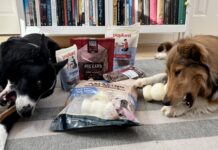Thank you for mentioning our product, Home Made 4 Life (“Food in the Freezer,” March 2000). Some important information was not mentioned in your article! We feel these key points set our companies and our product apart from our competition:
Home Made 4 Life pet food is formulated by professional animal nutritionists Jennifer Boniface, MS, and Trina Nowak, BScAgr, each of whom hold higher education degrees in animal nutrition.
Home Made 4 Life is the only international pet food of its type, with manufacturing taking place both in Maryland (Aunt Jeni’s Home Made) and Ontario, Canada (Pets 4 Life).
More details about the food can be found online at www.homemade4life.com.
-Trina Nowak
Ontario, Canada
-Jennifer Boniface
Aunt Jeni’s Home Made
Temple Hills, MD
Regarding your “Top Dry Dog Foods” article in the February 2000 issue: I understand that our Eagle Pack Natural Formula did not make the Recommended listing because we use the term “animal fat” in our ingredients list. The fat listed is pure bacon fat (pork fat), melted from human grade bacon to reduce the fat content prior to being shipped to restaurants. We also include chicken fat, produced under USDA inspection, the same fat sold to human food companies worldwide. There is no further refining or rendering.
Until recently, we used a mixture of the pork and chicken fat. We have since discontinued the pork fat.The “meat meal” listed is pure pork, from USDA-inspected plants. We are now changing our ingredients listing to state pork meal and chicken fat. These items were not listed as species-specific previously, because of ethnic considerations.
We subscribe to the nutrition philosophies of WDJ. As noted, our meat proteins and fats are from USDA-inspected plants with product sold to human food companies. Our carbohydrates/grains are ground fresh. There are no pesticides applied from the day the seed is planted until harvest. To prove the depth of our commitment, we now include certified, organically grown chicken in our cat food. As supply of this ingredient increases, we will include it in our dog food.
-John Marsman, Director of Nutrition
Eagle Products, Inc.
Mishawaka, IN
We’ve heard from representatives of several companies whose products did not make our “Top 10 Dry Foods” list for various reasons. Most wanted to communicate their reasons for making the decisions they did for using certain products (ones WDJ does not approve of ) in their formulations, or to explain why the ingredients they use are better in reality than they appear to be on the lists of ingredients found on their labels. Each person hoped we could further qualify or explain the listings on their labels.
In good conscience, all we can say is this: Virtually no one from any agency “polices” either the verbal claims of the food companies’ representatives or the literature published by the companies in pamphlets or on web sites. On the other hand, what is printed on their products’ labels is regulated by Federal law. For this reason, we suggest that consumers continue to judge foods by the list of ingredients found on their labels.
But here’s a wrench in the works: We recently learned that companies have six months to change the label of a food following any change in its formulation. This ostensibly protects the company from the expense of “wasting” perfectly good (but inaccurately labeled) bags.
Unfortunately, this practice leaves the consumer without any certainty that what they see is what their dogs will get. Especially vulnerable are dogs who have food allergies or other sensitivities. Short of calling the company every time you buy a bag of food, how can you know that no changes have been made that may affect your dog?
We’ll be looking into this practice further in future issues.
–Editor
Why didn’t you include hypothyroid disease as a possible underlying cause of itching in your article, “Stop the Itch!” in the February issue?
My Akita went through a couple of years of almost constant skin infections. We’d get rid of each infection with antibiotics, only to have it come back again quickly. Her constant scratching and biting were tormenting for her after a while, and her sad eyes often reflected that. Her thyroid tests were coming back normal, but as I got more desperate I began researching on the Internet. Eventually it was determined that she did have the disease when she responded within weeks to treatment. She’s never had a skin infection or serious itching since.
One estimate says that more than 90 percent of Akitas will have the disease at some point in their lives. Some other breeds are especially prone to it, too.
I had to take the initiative with my vet by bringing her the information; she wouldn’t have treated her for the disease based on the tests. The results of treatment were truly amazing. If publishing this information could help even one owner and dog with this problem, that would be great.
For more information about hypothyroid disease and its diagnosis and treatment, go to the Delaware Valley Akita Rescue web site (www.dvakitarescue.org) and ask for the thyroid packet. Their postal address is PO Box 103, Carversville, PA 18913.
-Grace Ramus
Princeton, NJ





